Yuchuan Wu
CPO: Addressing Reward Ambiguity in Role-playing Dialogue via Comparative Policy Optimization
Aug 12, 2025Abstract:Reinforcement Learning Fine-Tuning (RLFT) has achieved notable success in tasks with objectively verifiable answers (e.g., code generation, mathematical reasoning), yet struggles with open-ended subjective tasks like role-playing dialogue. Traditional reward modeling approaches, which rely on independent sample-wise scoring, face dual challenges: subjective evaluation criteria and unstable reward signals.Motivated by the insight that human evaluation inherently combines explicit criteria with implicit comparative judgments, we propose Comparative Policy Optimization (CPO). CPO redefines the reward evaluation paradigm by shifting from sample-wise scoring to comparative group-wise scoring.Building on the same principle, we introduce the CharacterArena evaluation framework, which comprises two stages:(1) Contextualized Multi-turn Role-playing Simulation, and (2) Trajectory-level Comparative Evaluation. By operationalizing subjective scoring via objective trajectory comparisons, CharacterArena minimizes contextual bias and enables more robust and fair performance evaluation. Empirical results on CharacterEval, CharacterBench, and CharacterArena confirm that CPO effectively mitigates reward ambiguity and leads to substantial improvements in dialogue quality.
TimeHC-RL: Temporal-aware Hierarchical Cognitive Reinforcement Learning for Enhancing LLMs' Social Intelligence
May 30, 2025Abstract:Recently, Large Language Models (LLMs) have made significant progress in IQ-related domains that require careful thinking, such as mathematics and coding. However, enhancing LLMs' cognitive development in social domains, particularly from a post-training perspective, remains underexplored. Recognizing that the social world follows a distinct timeline and requires a richer blend of cognitive modes (from intuitive reactions (System 1) and surface-level thinking to deliberate thinking (System 2)) than mathematics, which primarily relies on System 2 cognition (careful, step-by-step reasoning), we introduce Temporal-aware Hierarchical Cognitive Reinforcement Learning (TimeHC-RL) for enhancing LLMs' social intelligence. In our experiments, we systematically explore improving LLMs' social intelligence and validate the effectiveness of the TimeHC-RL method, through five other post-training paradigms and two test-time intervention paradigms on eight datasets with diverse data patterns. Experimental results reveal the superiority of our proposed TimeHC-RL method compared to the widely adopted System 2 RL method. It gives the 7B backbone model wings, enabling it to rival the performance of advanced models like DeepSeek-R1 and OpenAI-O3. Additionally, the systematic exploration from post-training and test-time interventions perspectives to improve LLMs' social intelligence has uncovered several valuable insights.
ChARM: Character-based Act-adaptive Reward Modeling for Advanced Role-Playing Language Agents
May 29, 2025Abstract:Role-Playing Language Agents (RPLAs) aim to simulate characters for realistic and engaging human-computer interactions. However, traditional reward models often struggle with scalability and adapting to subjective conversational preferences. We propose ChARM, a Character-based Act-adaptive Reward Model, addressing these challenges through two innovations: (1) an act-adaptive margin that significantly enhances learning efficiency and generalizability, and (2) a self-evolution mechanism leveraging large-scale unlabeled data to improve training coverage. Additionally, we introduce RoleplayPref, the first large-scale preference dataset specifically for RPLAs, featuring 1,108 characters, 13 subcategories, and 16,888 bilingual dialogues, alongside RoleplayEval, a dedicated evaluation benchmark. Experimental results show a 13% improvement over the conventional Bradley-Terry model in preference rankings. Furthermore, applying ChARM-generated rewards to preference learning techniques (e.g., direct preference optimization) achieves state-of-the-art results on CharacterEval and RoleplayEval. Code and dataset are available at https://github.com/calubkk/ChARM.
Reverse Preference Optimization for Complex Instruction Following
May 28, 2025Abstract:Instruction following (IF) is a critical capability for large language models (LLMs). However, handling complex instructions with multiple constraints remains challenging. Previous methods typically select preference pairs based on the number of constraints they satisfy, introducing noise where chosen examples may fail to follow some constraints and rejected examples may excel in certain respects over the chosen ones. To address the challenge of aligning with multiple preferences, we propose a simple yet effective method called Reverse Preference Optimization (RPO). It mitigates noise in preference pairs by dynamically reversing the constraints within the instruction to ensure the chosen response is perfect, alleviating the burden of extensive sampling and filtering to collect perfect responses. Besides, reversal also enlarges the gap between chosen and rejected responses, thereby clarifying the optimization direction and making it more robust to noise. We evaluate RPO on two multi-turn IF benchmarks, Sysbench and Multi-IF, demonstrating average improvements over the DPO baseline of 4.6 and 2.5 points (on Llama-3.1 8B), respectively. Moreover, RPO scales effectively across model sizes (8B to 70B parameters), with the 70B RPO model surpassing GPT-4o.
OmniCharacter: Towards Immersive Role-Playing Agents with Seamless Speech-Language Personality Interaction
May 26, 2025Abstract:Role-Playing Agents (RPAs), benefiting from large language models, is an emerging interactive AI system that simulates roles or characters with diverse personalities. However, existing methods primarily focus on mimicking dialogues among roles in textual form, neglecting the role's voice traits (e.g., voice style and emotions) as playing a crucial effect in interaction, which tends to be more immersive experiences in realistic scenarios. Towards this goal, we propose OmniCharacter, a first seamless speech-language personality interaction model to achieve immersive RPAs with low latency. Specifically, OmniCharacter enables agents to consistently exhibit role-specific personality traits and vocal traits throughout the interaction, enabling a mixture of speech and language responses. To align the model with speech-language scenarios, we construct a dataset named OmniCharacter-10K, which involves more distinctive characters (20), richly contextualized multi-round dialogue (10K), and dynamic speech response (135K). Experimental results showcase that our method yields better responses in terms of both content and style compared to existing RPAs and mainstream speech-language models, with a response latency as low as 289ms. Code and dataset are available at https://github.com/AlibabaResearch/DAMO-ConvAI/tree/main/OmniCharacter.
EPO: Explicit Policy Optimization for Strategic Reasoning in LLMs via Reinforcement Learning
Feb 18, 2025Abstract:Large Language Models (LLMs) have shown impressive reasoning capabilities in well-defined problems with clear solutions, such as mathematics and coding. However, they still struggle with complex real-world scenarios like business negotiations, which require strategic reasoning-an ability to navigate dynamic environments and align long-term goals amidst uncertainty. Existing methods for strategic reasoning face challenges in adaptability, scalability, and transferring strategies to new contexts. To address these issues, we propose explicit policy optimization (EPO) for strategic reasoning, featuring an LLM that provides strategies in open-ended action space and can be plugged into arbitrary LLM agents to motivate goal-directed behavior. To improve adaptability and policy transferability, we train the strategic reasoning model via multi-turn reinforcement learning (RL) using process rewards and iterative self-play, without supervised fine-tuning (SFT) as a preliminary step. Experiments across social and physical domains demonstrate EPO's ability of long-term goal alignment through enhanced strategic reasoning, achieving state-of-the-art performance on social dialogue and web navigation tasks. Our findings reveal various collaborative reasoning mechanisms emergent in EPO and its effectiveness in generating novel strategies, underscoring its potential for strategic reasoning in real-world applications.
OpenOmni: Large Language Models Pivot Zero-shot Omnimodal Alignment across Language with Real-time Self-Aware Emotional Speech Synthesis
Jan 08, 2025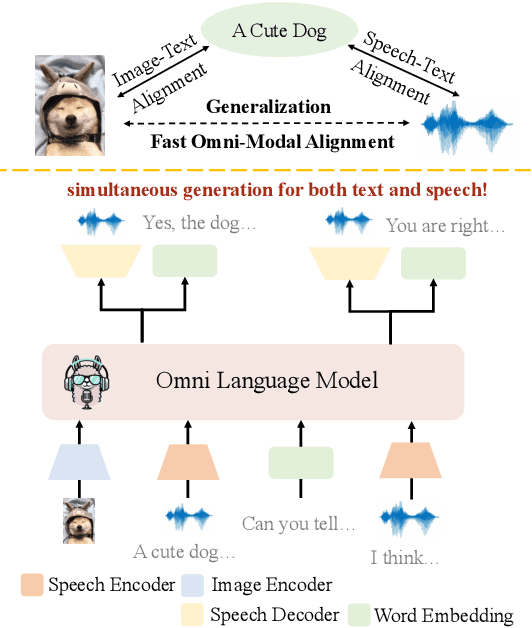



Abstract:Recent advancements in omnimodal learning have been achieved in understanding and generation across images, text, and speech, though mainly within proprietary models. Limited omnimodal datasets and the inherent challenges associated with real-time emotional speech generation have hindered open-source progress. To address these issues, we propose openomni, a two-stage training method combining omnimodal alignment and speech generation to develop a state-of-the-art omnimodal large language model. In the alignment phase, a pre-trained speech model is further trained on text-image tasks to generalize from vision to speech in a (near) zero-shot manner, outperforming models trained on tri-modal datasets. In the speech generation phase, a lightweight decoder facilitates real-time emotional speech through training on speech tasks and preference learning. Experiments demonstrate that openomni consistently improves across omnimodal, vision-language, and speech-language evaluations, enabling natural, emotion-rich dialogues and real-time emotional speech generation.
SDPO: Segment-Level Direct Preference Optimization for Social Agents
Jan 03, 2025



Abstract:Social agents powered by large language models (LLMs) can simulate human social behaviors but fall short in handling complex goal-oriented social dialogues. Direct Preference Optimization (DPO) has proven effective in aligning LLM behavior with human preferences across a variety of agent tasks. Existing DPO-based approaches for multi-turn interactions are divided into turn-level and session-level methods. The turn-level method is overly fine-grained, focusing exclusively on individual turns, while session-level methods are too coarse-grained, often introducing training noise. To address these limitations, we propose Segment-Level Direct Preference Optimization (SDPO), which focuses on specific key segments within interactions to optimize multi-turn agent behavior while minimizing training noise. Evaluations on the SOTOPIA benchmark demonstrate that SDPO-tuned agents consistently outperform both existing DPO-based methods and proprietary LLMs like GPT-4o, underscoring SDPO's potential to advance the social intelligence of LLM-based agents. We release our code and data at https://github.com/AlibabaResearch/DAMO-ConvAI/tree/main/SDPO.
MMEvol: Empowering Multimodal Large Language Models with Evol-Instruct
Sep 09, 2024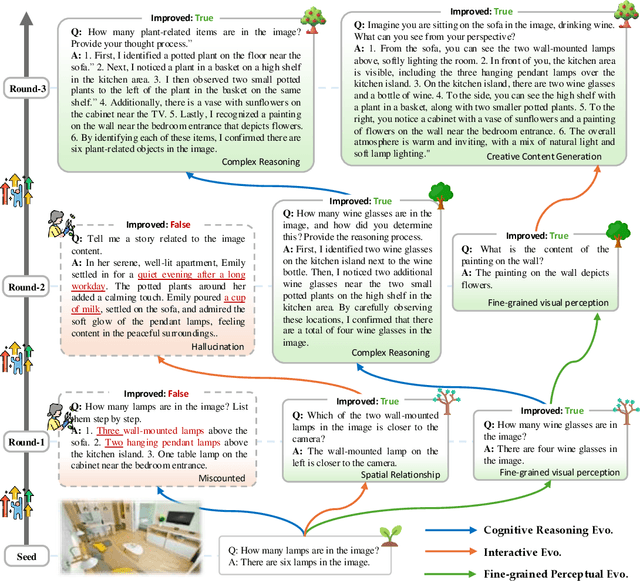

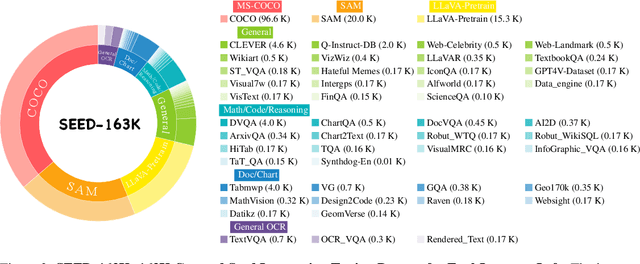

Abstract:The development of Multimodal Large Language Models (MLLMs) has seen significant advancements. However, the quantity and quality of multimodal instruction data have emerged as significant bottlenecks in their progress. Manually creating multimodal instruction data is both time-consuming and inefficient, posing challenges in producing instructions of high complexity. Moreover, distilling instruction data from black-box commercial models (e.g., GPT-4o, GPT-4V) often results in simplistic instruction data, which constrains performance to that of these models. The challenge of curating diverse and complex instruction data remains substantial. We propose MMEvol, a novel multimodal instruction data evolution framework that combines fine-grained perception evolution, cognitive reasoning evolution, and interaction evolution. This iterative approach breaks through data quality bottlenecks to generate a complex and diverse image-text instruction dataset, thereby empowering MLLMs with enhanced capabilities. Beginning with an initial set of instructions, SEED-163K, we utilize MMEvol to systematically broadens the diversity of instruction types, integrates reasoning steps to enhance cognitive capabilities, and extracts detailed information from images to improve visual understanding and robustness. To comprehensively evaluate the effectiveness of our data, we train LLaVA-NeXT using the evolved data and conduct experiments across 13 vision-language tasks. Compared to the baseline trained with seed data, our approach achieves an average accuracy improvement of 3.1 points and reaches state-of-the-art (SOTA) performance on 9 of these tasks.
FlowBench: Revisiting and Benchmarking Workflow-Guided Planning for LLM-based Agents
Jun 21, 2024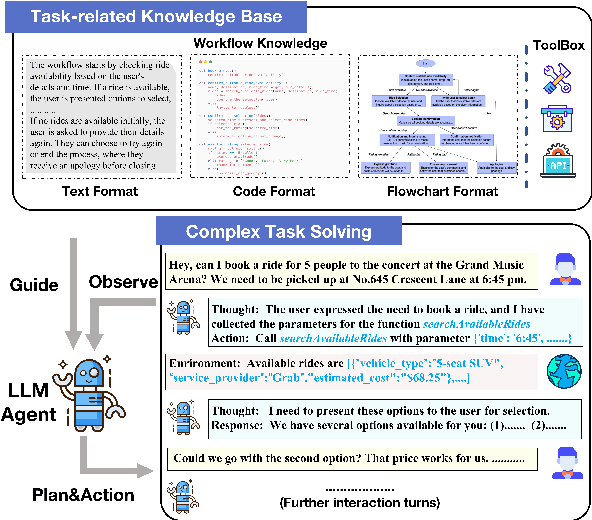

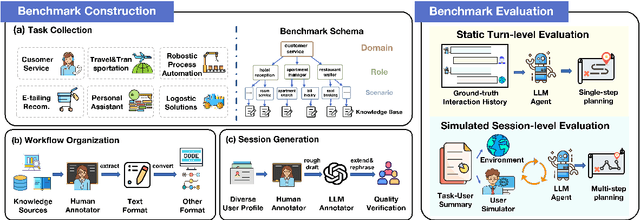
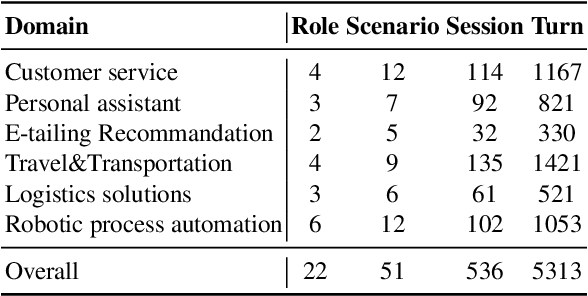
Abstract:LLM-based agents have emerged as promising tools, which are crafted to fulfill complex tasks by iterative planning and action. However, these agents are susceptible to undesired planning hallucinations when lacking specific knowledge for expertise-intensive tasks. To address this, preliminary attempts are made to enhance planning reliability by incorporating external workflow-related knowledge. Despite the promise, such infused knowledge is mostly disorganized and diverse in formats, lacking rigorous formalization and comprehensive comparisons. Motivated by this, we formalize different formats of workflow knowledge and present FlowBench, the first benchmark for workflow-guided planning. FlowBench covers 51 different scenarios from 6 domains, with knowledge presented in diverse formats. To assess different LLMs on FlowBench, we design a multi-tiered evaluation framework. We evaluate the efficacy of workflow knowledge across multiple formats, and the results indicate that current LLM agents need considerable improvements for satisfactory planning. We hope that our challenging benchmark can pave the way for future agent planning research.
 Add to Chrome
Add to Chrome Add to Firefox
Add to Firefox Add to Edge
Add to Edge